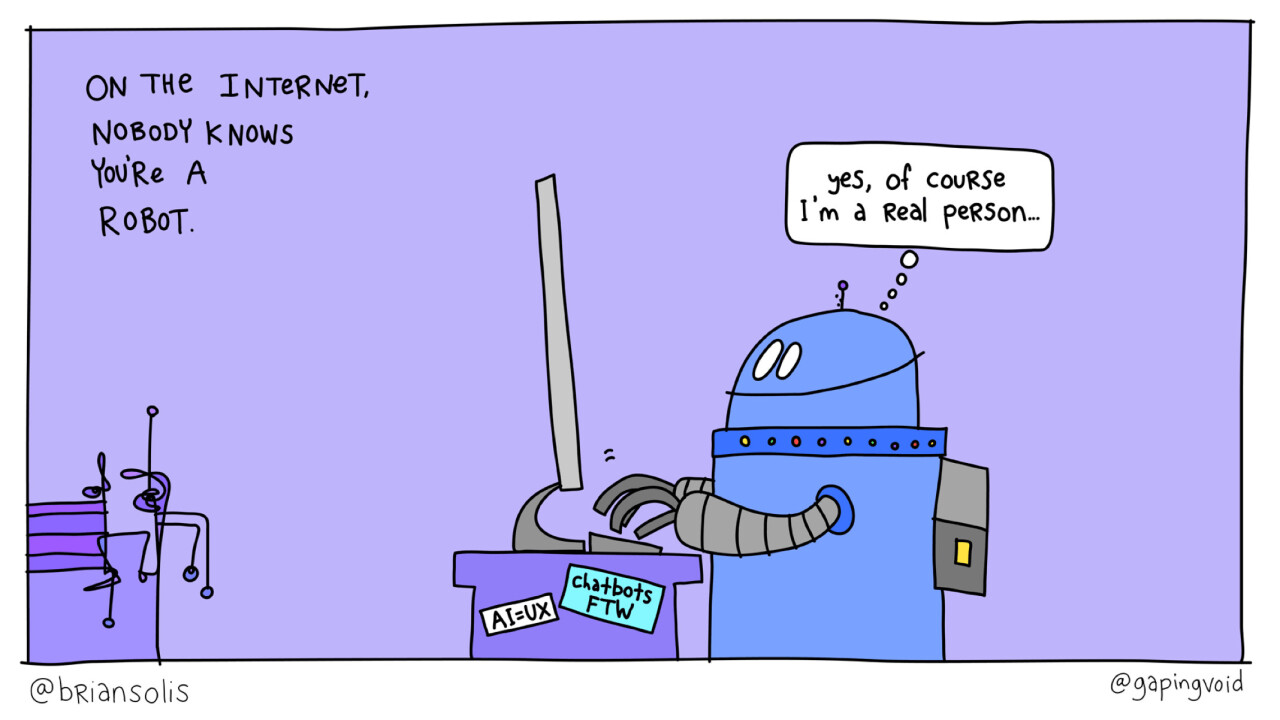
“I love seeing generic branded marketing messages!”
“I love it when products I looked at follow me across the interwebs.”
“I love getting mass emails and texts from brands and retailers!”
“Marketers produce my favorite content online!”
Chances are, you have never said any of the above. I mean, who would? Consumers don’t talk the way brands talk. So why do marketers continue to use the same old blueprint at a time when consumers have never been more connected and empowered?
The reality is that what consumers may have tolerated in the past is no longer what it will take to win their attention and loyalty moving forward. The game for marketing is changing as customers and their preferences, expectations and values evolve away from business as usual.
In an era of real-time, digital, social, mobile and augmented/virtual reality, marketers are gifted with new and inventive tools and platforms to reach consumers. And with the advent of artificial intelligence (AI), marketers have never had such a tremendous opportunity to humanize and personalize engagement.
So, what’s holding marketing back?
Legacy.
Yesterday’s standards, mindsets and blueprints still overly influence the future of marketing. Yet, technology and society continues to advance. Something has to change before the gap between marketing and consumerism grow further apart. The good news is that AI can help marketers bridge the gap while also rebuilding outdated marketing constructs.
It’s time to revisit the marketing checklist and also implement AI into the existing marketing stack.
We are and we are not the people we’re trying to reach
That’s the thing about marketing. We are all consumers. In our personal lives, we are the people we’re trying to reach. We’re connected, discerning, savvy, elusive, impatient, and self-interested. But when we go to work, we become “marketers.” We lose sight of who we are in the real world. Our thinking, perspective and behaviors shift. We become producers and strategists who see consumers not as people, but as audiences. We develop content for management and legal teams to approve.
Marketing strategies are broadcast to the masses across every possible channel. We talk at people without actually taking the time to understand who they are, what and who they value, their goals and aspirations, what they disdain and more importantly, how, where and why they make decisions.
At the same time, consumers are more connected and empowered than ever. They are in complete control of their journey from discovery to consideration to decision-making to the experiences they share. The devices they use, how and when, are also reshaping how they go in and out of their journey. Connected consumers expect personalization, immediacy, utility and simplicity.
Now more than ever, marketers must invest in extreme personalization to deliver useful, relevant and compelling information at the right time, on the right device, in the right channel, in the right frame.
Modernizing the marketing checklist in an era of AI
Legacy and rigid mindsets and standards have no place in shaping the future of marketing. Modern marketers need a modern marketing checklist to win over connected customers. This starts with an open mind and the ability to see customers differently and appreciate those differences to inspire more relevant and effective engagement. Below serves as a kick start to shift from old to new ways of modern marketing…
1: Shift from demographic segmentation to real-time behavioral segmentation.
Demographic segmentation helps marketers assess presumed preferences, likes, and dislikes of a group of people based on pieces of information such as their gender, age, and location. But the reality is that this doesn’t reveal personal behaviors and preferences of each consumer.
When marketers message everyone in the segment with the same message, it only resonates with a small percentage. Others feel that the message is unwanted and creates a more distant relationship between the brand and the consumer. It’s time to understand the needs of your consumer and communicate with them in ways that truly show you know them on a personal level.
Adding an AI-powered platform into the marketing stack humanizes consumers and how you communicate with them by helping marketers segment by real-time behaviors. These new systems stream behavioral data from points of interaction with your brand (e.g. your mobile application or website) to create behavioral segments based on your data.
2: Shift from canned messages to extreme personalization.
Sending everyone the same, impersonal message lacks context about the consumer’s past activities or engagement with the brand. Instead, AI helps marketers create and send personalized, useful, contextual messages that include personal attributes and also considers recent interactions and objectives.
3: Shift from broadcast distribution (reach) to right message, right time, right place, right device 1:1 engagement.
AI takes the guesswork out of marketing to help marketers deliver the right content tied to real-time consumer activity at the right time in the preferred channel and device. AI helps marketers craft extremely personalized messages, with relevant content in the channel and on the device they prefer and at the time they prefer to receive it.
When marketers consider both the content and the context of messages and ensure that the message speaks to the preferences they’ve inferred about an individual consumer, marketing becomes a whole lot more human.
4: Shift from a multi-channel or omni-channel approach to a cross-channel approach.
Today’s multi-channel approach places your brand in as many channels as possible, which promotes reach but not engagement. An omni-channel approach attempts to address the engagement problem, but the strategy is to just add and unify more types of channels (e.g. support, billing, shipping, etc.)
Brands must shift to a cross-channel approach where AI is used to learn, understand, and engage with consumers at the individual level with hyper-personalized, relevant, and timely communications, making them feel compelled to engage back.
5: Shift from generic customer experience strategies by humanizing consumer journeys and paths to purchase.
Study the organic behavior of your customers and determine the natural path they take to complete their desired goals. Use this as a basis for communicating with new consumers who have similar preferences and behaviors. Design personalized journeys that complement their behaviors and goals.
The modern marketing checklist places the consumer at the center of everything. It is data-driven to adapt and react to consumer preferences in real time. Strategies are informed based on the digital breadcrumbs consumers willfully leave behind, i.e. location, device, intent, and activity.
Modern marketing constructs use cross-channel vs. omni-channel models to engage in the moments, places, and messages that matter. The modern marketing blueprint also uses AI-powered systems to eliminate the guesswork of segmentation and messaging and use intelligent insights to engage every consumer as an individual, at scale.
The future of marketing is open. While marketing will always celebrate its past, legacy mindsets and standards give way to intelligent, automated and human-centered consumer engagement. Doing so earns an incredible competitive advantage by giving consumers the personalized, productive and enchanting experience they expect.
Get the TNW newsletter
Get the most important tech news in your inbox each week.




